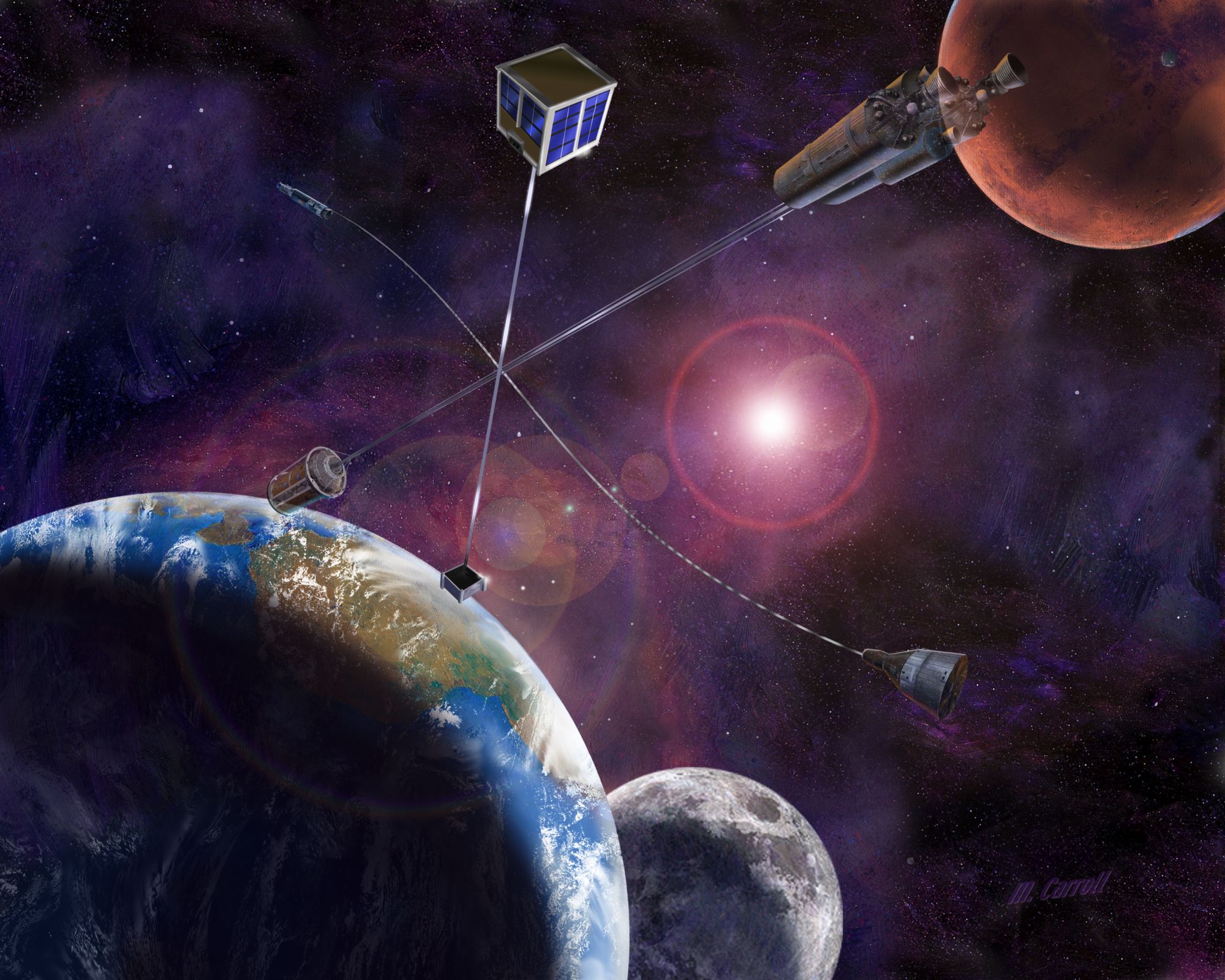|
|
 |
|
Here's the latest on space, and my opinions on it... This is the legacy site, with blog
entries from November, 2004 through June, 2011. Updates after June 9, 2011 can be found at http://spacewhatnow.com/SWN
|
 |
|
|
Saturday, March 20, 2010
Really Bad Sausage is Made This Way...
The more I hear people talk about alternatives to the Obama proposal for NASA, the more nervous I get about the outcome. Obama's space policy is the policy that's made the most sense to me that I know
of in this administration. It concerns me that an administration that seems to think that "more government" is the answer
to every problem chose "less government" for spacefaring, but, if done properly, the original Obama policy had the chance
to make space routine and really open it to lots of people.
New ideas, about having NASA continue to work on some vestige of the Constellation program while commercial efforts move forward
as well, are the worst of both worlds. Powerful forces within NASA see the agency as a rocket building agency. Unless they
are told categorically to stop, they will continue to believe that and build. When budget cuts come and development costs
rise, will the rocket building segment of NASA be cut? No. First, the portion of the agency assigned to "purchase" flights
from commercial vendors will get cut, decreasing the flight rates on those vehicles to near today's levels...where no volume
cost decrease takes place. At that point, someone will declare "Aha! See! Commercial spaceflight doesn't work!" and we'll
be in a worse mess than we are right now.
Cynical? Yes. Likely? I'm pretty sure.
Tuesday, March 16, 2010
SpaceX and Unflown Rockets
SpaceX announced another commercial customer for their Falcon 9 booster today, hot on the heels of their successful test firing at the Cape this weekend.
While people decry SpaceX as a company which hasn't flown their big rocket yet, there were customers lined up for Delta IV
and Atlas V launches before those boosters flew. The difference is that, in the case of DIV and AV, people knew the government
would keep shoveling money at them until they worked. While that 'trust and confidence' isn't as strong in the case of SpaceX,
the company has a lot of government work lined up, and it's definitely in their interest to get flying regularly.
9:11 pm est
Saturday, March 13, 2010
Asteroids Revisited
A few years ago now, I wrote an article about asteroid missions. How, despite their hype and seeming ease, there's an involved dance between launch window frequency
and the amount of delta-v (which translates to propellants) required for the mission. Since that analysis, I've gotten more
familiar with the Jet Propulsion Lab's NEO Page, and realized that the tools exist on the page to do the analysis I did. Oh well. It does make it easy to check back and
see if the asteroids I considered are still high up in the running for low-delta-v missions. Checking here, they've held up pretty well. 5 of my 6 asteroids investigated are in the list of 50 space rocks that will approach our
planet relatively slowly. There's a new one since I wrote the article, 2009 BD, that's doing some sort of dance with Earth right now with multiple close approaches at low speed. The problem is that it
may be hundreds or thousands of years before it does so again.
According to this article, 2009 BD is a co-orbital asteroid,that will hang out with us for a while before being slung into space by a too-close swingby
of the moon.
SUNDAY MORNING UPDATE(Daylight Savings!): 2009 BD has a VERY SLOW flyby at 11.2 x lunar distance on July 12th this year.
Such an opportunity is a great reason to have an asteroid explorer on standby, ready to fly on something like an Air Force
Operationally Responsive Space vehicle. Dang! Looks like there was a conference that ended on Thursday!
I want to see this math
The Air Force stated that NASA didn't consult with them on the new direction for human spaceflight, and that preliminary analysis
shows the new approach could increase launch costs for The Pentagon and other government agencies. Discussion here.
Considering that the original idea of the Evolved Expendable Launch Vehicle (what became Delta IV and Atlas V) was to reduce
cost through large-scale production and launch, the Air Force must be thinking that they're not going to be flying Delta IVs
and Atlas Vs much more on the new plan, and any additional flights will have to have additional, TBD, 'human rating' requirements
put on them. My thoughts were the opposite. If the Delta IV and Atlas V assembly lines were to be cranked up to their maximum
rate, (42 Delta IV cores per year according to a tour guide at Cape Canaveral) costs would go DOWN.
According to some of the discussion at Rand's place, the concern is over the cost of producing solids. Both Atlas V and Delta
IV use solids in some configurations. The thought is that the loss of the solid rocket booster market will cut production
of solid rocket propellant so much that the price will go up. That's viable, I guess, but as Rand said, the DoD shouldn't
have been relying on NASA to offset their launch costs anyway.
Wednesday, March 10, 2010
Space Battle Looming
Through a couple email exchanges with friends who supported various forms of the status quo in the US's space policy, the
best summary I could come up with of my feelings went something like this: The US can claim that they never gave
up their "#1" role in space (whatever that means) by getting civil servants flying again on a government-contract-built spacecraft
in the year 20XX (I've seen estimates as early as 2013, which strikes me as completely ridiculous considering that Ares I
wasn't going to fly until 2017 at the earliest). Another option is that the US could claim a "#1" role in space through the
launch hundreds of tons of experimental hardware, supply storage, and delivery vehicles in the same period of time for less
money than the development of the government-contract-built spacecraft. Some of the bills being proposed in Congress, keeping shuttle flying and fighting for various portions of the old program to stay on the books
is pretty much the worst of all worlds. Without a large increase in funds, keeping vestiges of the past around is just a
money sink. If NASA has the promise of eventually building and flying its own rocket, that's where their focus will be.
Commercial launch services will be the first to be cut when funding gets tough.
I think that, in the case of the Obama NASA budget, it's a case of the government doing the right thing for the wrong reason.
I do find it strange that this administration's focus in just about every other area is "Government is the solution", while
here, for US efforts in space, the answer is "Let the private sector do it."
New Hubble Movie
Considering that I saw the camera in the high bay at Goddard, I guess I should go see the movie that it shot.
Sunday, March 7, 2010
Obama Giving the Space Program his Personal Touch
President Obama is holding a Space Summit in Florida on the 15th of April. This happens to be the last day of The Space Foundation's National Space Symposium.
I'm sure it will work out at least as well as the other projects he's traveled to take part in...
Saturday, March 6, 2010
I Thought the Science was Settled
On an asteroid taking out the dinosaurs. Turns out: "It is almost impossible to change the skeptics' minds," Goldin concedes. At least he
didn't call those who still disagree "impact deniers."
|
|
|
 |
|
|
|
 |
|
Space: Search Now! with Google
| Tom and Discovery |

|
| Taken During a Tour of KSC on 6 Oct 2010 |
| TEMPOł Update |

|
| Click on the picture to go to the Mars Society TEMPOł Page |
| Solar System Ambassadors |

|
| Click on the image above to see Tom's SSA profile |
Email Comments to tom [at]
spacewhatnow.com
| Latest book! Click on the cover to purchase |

|
| I Want to go to Mars is a picture book for beginning readers |
More information on I Want to go to Mars can be found in the devoted section of this web site.
Join the Space:What Now? email list for updates on book events or articles published by the author. Email
addresses will not be shared.
I kind of wrote this off, thinking I was being spammed, but I'd like to know if people are really signing up. Please enter
the text you see below in the second line, and I'll get a warm, fuzzy feeling that people are actually reading and signing
up for mail!

| Now Available! |

|
| Clicking here will take you to purchasing options for SWN |
| Get your SWN Gear! |
|
|
| Powered by CafePress |
|
 |
|
|
|
|
|
Scotty
The Updated Past, Present and Possible Futures of Space Activity
|
|
|
 |

